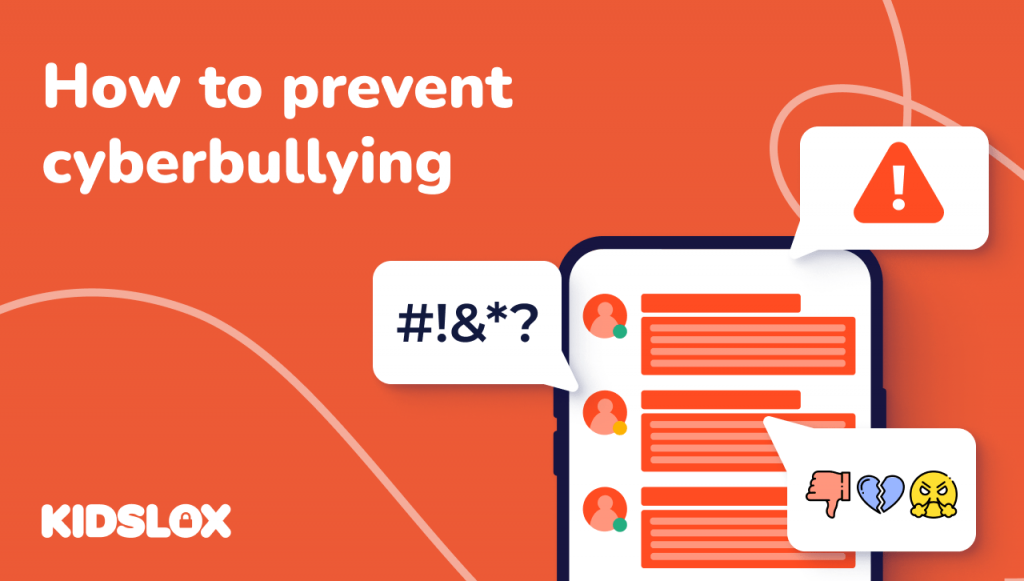Bullying doesn’t just take place in the playground. It isn’t just a shove in the school corridor or a nasty whisper at the back of the classroom. Cyberbullying is a real and insidious phenomenon in our schools and communities. And, while it can feel like a recent development, cyberbullying has been going on in children’s lives for two decades.
This article explores how we – as parents, caregivers, teachers, and friends, can spot the signs of cyberbullying, take effective action to prevent it from happening, and help protect children from its damaging effects.
What is cyberbullying? A summary:
Cyberbullying can be defined as harassing, threatening, and intimidating another person using electronic means. With the proliferation of social media, gaming sites, and other digital apps, the ways in which children are being cyberbullied are varied and growing. Cyberbullying can take lots of forms. For example, it may look like this:
- Purposefully setting up a ‘hate account’ to bully someone and shame them
- Toxic messages on gaming platforms and other online communities
- Repeated harassing messages to someone
- Deliberate attempts to infect a victim’s computer with a virus
Cyberbullying is unfortunately very common. According to the campaigning group, Enough is Enough, 49% of children between the ages of 10 and 16 reported that they have experienced cyberbullying.
The group also reported that young people under the age of 25 who have experienced cyberbullying are more than twice as likely to self-harm or enact suicidal behavior. Something that is also mirrored by the perpetrators. Indicating that like ‘traditional’ bullying, the bully-victim dynamic is a complex one.
What are the effects of cyberbullying and why does it happen?
Just like ‘real world’ bullying, cyberbullying has a significant impact on a victim’s quality of life and emotional, and physical health. Over 30% of children who have experienced cyberbullying report symptoms of stress.
Feeling isolated, scared, and belittled are all ways in which cyberbullying can impact a child emotionally. The distraction, and stress, can cause them to lose focus on schoolwork and things that they once loved. And, in extreme circumstances, it can be a factor for self-harm and suicidal thoughts.
The relative anonymity of the internet gives bullies a mask to hide behind. The ease of setting up new accounts and email addresses allows bullies to continue to shapeshift behind the scenes and escape culpability.
In a lot of instances, this type of bullying can be more extreme, hurtful, and incendiary. Children may see the online landscape as removed from ‘real-life’, and the fact they can hide their identity makes it easier to push boundaries and detach themselves from the emotional realities of what they’re doing. They can fail to see the consequences of their actions and are often too immature to understand the real impact of their words.
How can schools prevent cyberbullying?
According to a Google Survey, the number one safety concern that teachers have about the classroom is cyberbullying. Platforms that find their audiences in tweens and teenagers like TikTok, Twitch, and Snapchat are of particular concern because parents and teachers can feel removed from them if they’re not familiar with how they work and how children are using them.
Throughout the pandemic, with limited social interactions and access to regular schooling and structures, various studies show that cyberbullying reports reduced. Researchers are unclear as to why this was exactly the case. Some believe that the increased time spent with caregivers helped to mitigate the insecurity triggers that often lead children to bully others. It has also been suggested that the combination of online and in-person interactions can fuel bullying incidents. Without these moments, opportunities are decreased.
When it comes to preventing cyberbullying from inside of the school and into the online setting, it’s all about culture. Every school should have comprehensive anti-bullying policies for what happens on school grounds and during school time, but this must extend online too.
Experts also recommend that schools should foster a culture of telling and create an environment where this can be done without fear of reprisal. Children should be educated and empowered about the differences between ‘tattling’ and the sharing of information that could keep someone else safe.
Students should also receive positive reinforcement that coming forward about their experiences, or that letting a teacher know that another child is a victim was the right thing to do.
Teachers should also encourage children to make sure they don’t delete ‘evidence’ of bullying so that it can form part of a proper investigation into the behavior. An open culture of looking out for one another is another way of positively reinforcing good behavior, and limiting the places where bullies can hide.
Alongside parents, online safety should form a part of children’s education and caregivers should work together to provide practical solutions to preventing cyberbullying through regularly changing passwords, never sharing private details, and only ever interacting educating online with those who you know ‘IRL’.
How can parents prevent cyberbullying?
The sad truth is that just as in the real world, it is impossible to completely shield children from harm brought on by others, but there are practical and emotional ways in which parents can prevent cyberbullying.
- Show them love, and support. Make sure your child always feels listened to, and that the home is an environment in which they can discuss things openly without judgment. Let your child know they are always safe with you, and that you’ll do whatever it takes to keep them so.
- Look out for changes in their behavior in case something is wrong. Victims of cyberbullying can exhibit signs that something is happening to them that you might not be fully aware of. Look out for changes in eating habits, a reluctance to go to school, complaints of headaches or other physical ailments, low mood, and a lack of interest in things they previously enjoyed. If you’re ever worried, always talk to your child and your health professional. More tips can be found here.
- Take an active role at school by making sure you know the ins and outs of the school’s anti-bullying policy. Don’t be quiet if you feel things aren’t addressed properly, and keep an open and honest dialogue with other parents.
- Teach the difference between ‘telling tales’ and reporting. Empower your children to ‘do the right thing’ by teaching them that reporting behaviors is keeping your friends safe, and that’s all a part of making a positive contribution to your community.
- Teach empathy and resilience from a young age. Let your child know that sometimes people are cruel, but that it’s only because they’re hurting inside themselves. Prioritize and practice kindness. Arm your children with the skills they need to thrive socially by encouraging them to be the ones to comfort and play with someone who is having a tough time.
In order to help prevent exposure to cyberbullying, here are five practical ways you can help your child:
- Password protection. Make sure that your child understands how to keep their passwords safe, and their devices secure. Teach them about regularly changing passwords and how to create strong ones.
- Teach about online privacy. Limit who can see what your child is sharing online and educate them about the consequences of sharing too much of their personal life with others on social media platforms. Ensure they know about security settings, and that they never share their location or other details online.
- Never connect with strangers. If your child knows absolutely everyone they have online connections with in person, they are limiting the opportunities that ‘fake accounts’ have to target them with anonymous messages and hate. You can help children with this by setting up a cell phone contract with technology guides and rules.
- Report and disengage. If your child does become a victim of cyberbullying it’s important to ignore the interactions, keep the evidence and report the account immediately to the social platform it was through. Share the account details with the relevant authority figures at school to make them aware of the activity.
- Limit exposure online. The less time your child spends plugged into social media and other online messaging channels, the less exposure they will get to cyberbullies. Promote a healthy, balanced approach to technology in your home, and encourage and inspire your children with their physical hobbies and social interactions. If you need support setting limits and protections on your child’s devices, KidsLox can help. Try our free trial and start setting healthy habits today.
Here are some more resources and organizations that offer professional advice on cyberbullying prevention:
- Cyberbullying Research Center offers the latest data, insights, and recommendations to help prevent cyberbullying
- PTA.org has advice on how to prevent cyberbullying between schools and parents
- Stopbullying.gov has a dedicated section for cyberbullying, including regulations and advice for parents







